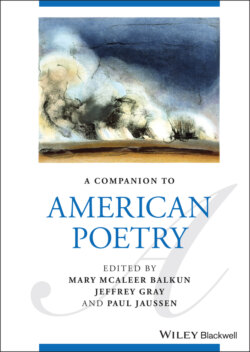Читать книгу A Companion to American Poetry - Группа авторов - Страница 38
The Question of Myth
ОглавлениеThe position that these scholars of religious history take—that it is a myth that the modern world experienced a loss of myth—leads us to the mythic modes of thought that are central to modernist poetry. One thinks of T. S. Eliot’s essay “Ulysses, Order, and Myth” (1923), in which Eliot defines the mythic method as “manipulating a continuous parallel between contemporaneity and antiquity” so as to develop “a way of controlling, of ordering, of giving a shape and a significance to the immense panorama of futility and anarchy which is contemporary history” (Eliot 1975, p. 177). Eliot’s fascination with myth, and his study of such works as The Golden Bough and From Ritual to Romance, do not, of course, simply result in a “method” of composition. The poet’s manipulation of myth in order to produce the “continuous parallel” between past and present generates a sense of supernatural timelessness (implicit in The Waste Land and explicit in Four Quartets) which may in turn counteract what Eliot regards as the worst tendency in modern literature. As he declares in “Religion and Literature” (1935), “modern literature is corrupted by what I call Secularism, that it is simply unaware, simply cannot understand the meaning of, the primacy of the supernatural over the natural life: something which I assume to be our primary concern” (Eliot 1975, p. 105).
In contrast to Eliot (although influenced by him), Hart Crane considers myth in a less severe and more anticipatory manner. Crane cannot subordinate himself to old myths and recycle them: “The great mythologies of the past (including the Church) are deprived of enough façade to even launch good raillery against” (Crane 1966, p. 218). In contrast to Eliot’s Anglo-Catholicism, Crane’s spiritual vision, following that of Whitman, is deeply American: “I feel persuaded that here [in America] are destined to be discovered certain as yet undefined spiritual quantities, perhaps a new hierarchy of faith not to be developed so completely elsewhere” (Crane 1966, p. 219). Hence the poet, in the famous last lines of “To Brooklyn Bridge,” beseeches the bridge to “sweep, descend/And of the curveship lend a myth to God” (Crane 1966, p. 46). This new myth, envisioned through the technologies of modern life, comes into being because “New conditions of life germinate new forms of spiritual articulation” (Crane 1966, p. 222).
According to Allen Grossman, “Crane tended in his poetry to hallucinate mechanisms, and structures, to repeat the problem of form as image as a way of searching for, voyaging toward … the space he sought, where all the powers and justly desired outcomes of sentiment would be simultaneously at home” (Grossman 1997, p. 102). Grossman calls these image-forms “Orphic machines.” Another more familiar term for them might be archetypes, just as the space which Grossman tells us that Crane sought might be called the collective unconscious. For C. G. Jung, the archetype is a “primordial image… that constantly recurs in the course of history and appears wherever creative fantasy is freely expressed. Essentially, therefore, it is a mythological figure” (Jung 1961, p. 81). Mythic or archetypal thinking is inescapable when one considers modern poetry and belief: “The creative process, so far as we are able to follow it at all, consists in the unconscious activation of an archetypal image, and in elaborating and shaping this image into the finished work. By giving it shape, the artist translates it into the language of the present, and so makes it possible for us to find our way back to the deepest springs of life” (Jung 1961, p. 82). Sounding like Eliot, Jung sees this process as rectifying “the inadequacy and one-sidedness of the present” (Jung 1961, pp. 82–83), though as we see in regard to Crane, archetypal thinking—and writing—need not be socially reactionary in the way in which it connects contemporary life with primordial myth.
This leads us back to the question as to whether the loss of myth under the conditions of modernity is itself a myth. The status of myth under modern conditions is ambiguous, indeterminate; it is, to use Jean-Luc Nancy’s term, “myth interrupted.” If the secularism of enlightenment is a myth, then myth is a myth as well. As Nancy puts it, “The phrase ‘myth is a myth’ harbors simultaneously and in the same thought a disabused irony (‘foundation is a fiction’) and an onto-poetico-logical affirmation (‘fiction is a foundation’). This is why myth is interrupted. It is interrupted by its myth” (Nancy 1991, p. 55). If this is the case, then the self-consciousness of modern archetypal thinking always undermines itself; it is part of the destabilized dialectic of reason and belief. As Nancy tell us, “A name has been given to this voice of interruption: literature” (Nancy 1991, p. 63). Let us see how this plays out among modern poets.
